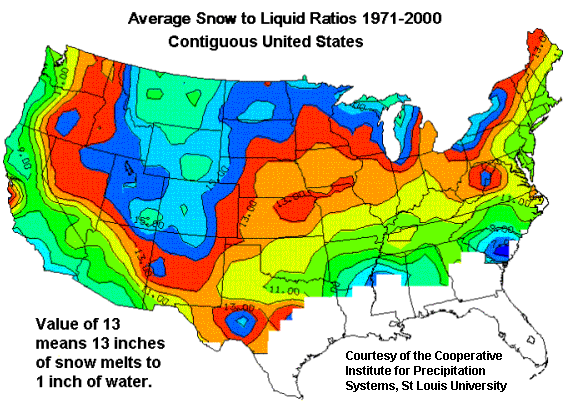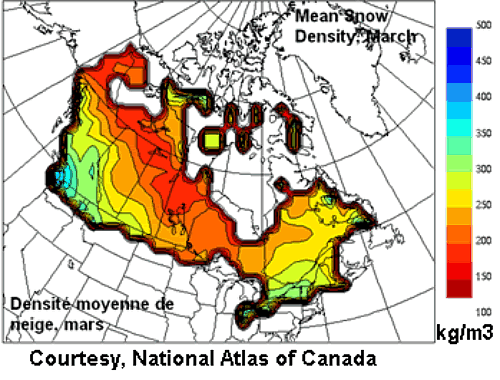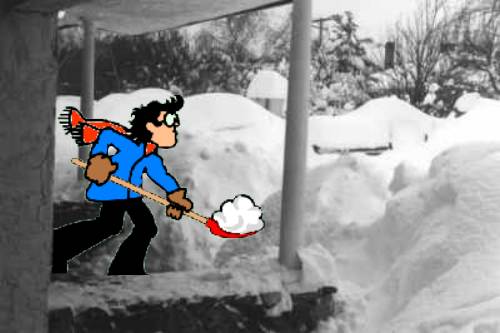 |
 |
| Home | Welcome | What's New | Site Map | Glossary | Weather Doctor Amazon Store | Book Store | Accolades | Email Us |
 | |||||||||||||||||||
Weather Almanac for February 2007THE WEIGHT OF SNOWFor much of this winter, the snowfall here in the British Columbia mountains has been of the light, powdery variety. Whenever we had an accumulation, I could easily clean the car and driveway with the sweep of a broom and the push of the snow shovel. It was more snow-walking than snow shovelling, barely a need for any lifting. Then last week, the wind howled a gale, blew the snow around and packed it into a dense, hard mass. When I went out to clean the drift behind the car, it was like moving drywall, forming dense panels in my shovel that would have been ideal for igloo construction. Needless to say, the next day, my back muscles complained vigorously. As I moved gingerly about my studio and office and worked on the sketch for a blizzard painting, I thought about how different snow really can be from one place to another and from one time to another. For example, my previous home in Victoria usually only had an accumulating flurry or two in most winters, and snow was easily pushed around, like the shot below of my neighbour who cleaned his car windows with a hockey stick (do you call that high-sticking?). Then, a decade past during the holiday season of 1996, we had the great snowstorm (pictured on right) that buried the cars in the parking lot. That snow was mixed heavily with rain, and weighed the proverbial tonne. I was afraid that the heavy weight of snow on my car roof (middle lump in the picture) might compromise the sunroof's seal and cause water damage in the interior. I took the only implement I had for moving snow, a dustpan, and shovelled the heavy layer from the roof top.
During that storm, many buildings, particularly greenhouses and boat houses collapsed due to the snow's weight, and several people suffered heart attacks trying to clear walks, doorways and driveways — and likely many more sustained back injuries and muscle pains. The Weight of SnowWhen you look at the basic building block of snow, the ice crystal, it looks so gossamer small and delicate that you assume it has no weight at all. And while individual snow crystals are quite light on the grand continuum of weights, when they aggregate by the billions and billions, a little becomes a lot. And those crystal accumulations make very good masses for holding liquid water — through rainfall or melting — which can increase the weight of a specific volume of snow immensely. Meteorologists developed a rule of thumb years ago that said ten inches (25 cm) of snow would melt down to 1 inch (2.5 cm) of water (or be the equivalent amount of rain if it fell as liquid), and that proportion was often used to determine the amount of equivalent precipitation from a snowfall. But that 10:1 ratio, we now know, is far from exact, and generally wrong across the breadth of conditions under which snow falls, even within an individual storm. Exact measurements of the snowfall to water ratio are made at some climatological stations in many areas of the continent. In European climatological summaries, they do not generally report the depth of a snowfall or the snowpack but report instead the liquid water equivalent. Such knowledge is extremely important in assessing avalanche dangers, forecasting flooding potential or degree of blowing and drifting snow, and assessing water resources. One method of conversion is simple, a sample of the snow collected in the gauge is simply melted with gentle heat, so as to minimize evaporation, and the remaining water depth measured. Another way is to add antifreeze to the gauge that melts the snow as it falls. The increase in the amount of liquid in the gauge indicates the water equivalent of the snow. When snow falls at air temperatures around freezing (32 oF / 0 oC), the ratio of snow to water equivalent comes close to the 10:1 ratio. However the full range is from around 100:1 to 3:1, depending on other weather factors such as air temperature, snow crystal structure and wind speed. In the United States, the ratio typically falls in the 8:1-20:1 range: the standard value used by the US National Weather Service for converting snowfall into liquid water equivalent when observers cannot melt down the gage-caught snow is 13:1. We generally characterize a snowfall as dry when the ratio is higher than the 15:1 mark, and as wet when the ratio is below 6:1. Because of the high water content, wet snow is sticky snow and good for packing into snowballs and snowmen, but bad for shovelling and accumulation on structures.  Annual Average Snow:Water Ratio for United StatesAmong the greatest variations in snow–water ratio are found in the western mountains of the US and Canada. Studies in the Rockies indicate that the lowest ratios — 20:1 to 100:1 — are found in the fluffy snows falling under light winds and temperatures around - 9 oC (15 oF). At colder temperatures, the snow crystals change shape and are generally smaller and thus pack more closely. Near and below -18 oC (0 oF), the snow to water ratio is usually 10:1 or less. In the great East Coast of March 1993, the snow–water ratio ranged across the Appalachian Mountain chain from 4.2:1 at Asheville, North Carolina to 14.0:1 at Binghamton, New York. Snow DensityWe know that pure water density is around 1000 kg (or one tonne) per cubic metre or 62.4 lb per cubic foot. Pure ice is just slightly less dense than pure water at about 917 kg per cubic metre (that is why ice floats on a pond or in our drink). Snow on the other hand has less density because it contains more air in a given volume than the ice. Heavily compacted snow, called firn, can be nearly as dense as ice (around 910 kg per cubic metre) but newly fallen snow more typically weights in at 70 to 150 kg per cubic metre (4.4 to 9.4 lb/cubic foot), but this increases rapidly once snow is on the ground and it begins to compact due to wind, the addition of liquid water and its own weight. Once on the ground, a snowfall becomes a snowpack unless it quickly melts. The density of the snowpack reflects the conditions during the snowfall and processes that occur to and within the snowpack as it ages. These include compaction by weight and wind, snow melt and cycles of thaw-freeze. Drifted snow is usually denser than undisturbed snow because the crystals are initially smaller and more compact, as I recently rediscovered. Additional rain falling on a snowpack can quickly increase the snow load because a snowpack can absorb rain until it's about 45% saturated. (The snowpack will start melting when the saturation is above 45%.) The density of a snowpack and changes in the density with depth are essential ingredients for avalanche forecasting and danger warnings. Typically winter snowpacks have a density of 200-300 kg per cubic metre (12.5-18.7 lb per cubic foot), but this can vary with the moisture content of the snow and that can vary across climatic regions. Dave Phillips of Environment Canada reports that one cubic metre of old snowpack in Winnipeg, Manitoba typically weighs around 190 kg (419 lb) and the same volume weights 220 kg (485 lb) in Quebec City. In the wetter climate of British Columbia it is generally higher, at Whistler, BC the same cubic metre may weigh 430 kg (948 lb).  The figure here from the National Atlas of Canada shows the mean snowpack density across Canada for March. The spatial pattern is characterized by higher snowpack densities in warmer coastal regions and lowest densities over the boreal forest zone. A freshly fallen snow may be light and fluffy, but it can easily and quickly turned to a hard and thick material, that can be used for construction — of snow forts and even snow shelters. Compressed snow may have less strength than ice, but it has significantly better insulating properties because of the many air pockets between the snow crystals. So how heavy is that snow covering your driveway or sidewalk that demands to be shovelled? You can estimate that rather quickly. First, 1 mm of water spread over a square metre weighs one kilogram. We'll assume here a 10:1 snow–water ratio, so 1 cm of snow on a square metre weighs a kilogram. Next calculate the area of your driveway or walk in square metres. For this example, let's assume a driveway of 15 x 4 metres which gives 60 square metres. Then multiply that by the average depth of snow on the surface, I took 5 cm. Finally multiply that number by 1 kg. That gives 60 x 5 x 1 kilograms or 300 kg. If the drive is covered with heavy, wet snow, you could increase the weight by a factor of two to four, giving 0.6 to 1.2 tonnes! For Imperial units and the same snow–water ratio, one inch of snow over a square foot of surface weighs about 0.52 pounds. So here, multiply the surface area to be shovelled, say a 45 ft by 10 ft driveway, which is 450 square feet by the depth of snow, say 2 inches, and then multiply that by 0.52 lb gives 468 lb of "normal" snow to move, and 900 to 1800 lb of wet snow. Weighing Down the RoofA driveway can be a heavy load of snow to shovel off, but it has Mother Earth to hold up the weight. A roof or other structural component may need to hold that weight and more. My roof is basically flat and has an area of around 100 square metres, so if 5 centimetres of "average" snow accumulated on it, my home must supports weight of 500 kg (1100 lb), wet snow could triple or quadruple the amount. During the 1996 snowstorm in Victoria, many commercial greenhouses and boat sheds around town collapsed under the weight of snow as well as an airplane hanger at the airport. I am sure many canvas or plastic topped carports, gazebos, awnings and home greenhouses were damaged as well by the wet of the fresh snow and the added rainfall soaked up by the snow.
So that such collapses are not common, building codes for local jurisdictions specify the amount of snow a building must be designed to handle. The code usually has local loading requirements based on the local snow climate. Depending on the building use, the loading may be calculated from the distribution of local ground snow load over the climatological record. Maximum ground snow loads for specific mean recurrence intervals (MRI) are used in the determination. The mean recurrence intervals taken in the codes are usually 25 years, 50 years, and 100 years, depending on the intended building usage. For a 50-year mean recurrence interval, there is one chance in 50 (or two percent) that the ground-snow load in a given year will exceed the 50-year MRI value. The shortest interval (25 years) is used for buildings, such as agricultural buildings were there is a low risk to human life. Essential buildings such as fire halls, police stations and emergency shelters are usually designed to a 100-year MRI or better. Many factors in addition to the total snowfall/snowpack must be considered in determining the snow load, and these include weather factors and building factors. Weather factors include snowfall, snow density, wind, drifting snow, temperature, melting–refreezing cycles, and rainfall. Building factors include roof slope, surface "slipperiness", thermal conditions, type of roof, roof aspect, and roof topography in the case of complex roofs with penthouses or equipment. Human Health...A Weighty MatterThe weight of snow also has human health consequences, both good and bad. First, the good news. Snow shovelling can comprise a good workout for those in proper condition. The US Surgeon General's Report on Physical Activity and Health for 1996 reported 15 minutes of snow shovelling can count as moderate physical exercise, the same level as running at 15 km/h. But the bad news is that shovelling a moderate or large amount of snow puts a great stress on the body. Both the cardiovascular system and the muscles come under stress. An average shovel-full of snow can weight 10-30 kg (22 to 66 lb). Shovelling for around fifteen minutes can have you lifting a couple tonnes of weight.  Working this hard in cold weather can increase heart rate and blood pressure and cause shortness of breath. Heart attacks are often the leading cause of death during winter storms, as people unaccustomed to heavy physical activity feel compelled to clean their driveways and sidewalks. Often the anxiety created by the snowfall — fears of being late for work, driving in such conditions, etc. — has the heart rate elevated even before the shovelling starts. Then with the strain of shovelling, heart rates can rise above levels considered safe for hard aerobic exercising. The second risk of snow shovelling, and perhaps the most common, is injury, mostly pulled muscles and back and neck strain. Most shovellers, out in the cold weather, do not properly warm up their muscles which increases the risk of pulls and strains. Most shovellers try to lift and throw shovel loads of weight that they are unaccustomed to moving. Physiotherapists suggest warming up and stretching beforehand and taking smaller loads in the shovel. And whenever possible, push or pull the snow rather than lift it. Even those who work out with weights can feel the strain as most often the shovelling act includes a twist of the spine with the lift rather than a straight lift. Learn More From These Relevant Books
|
|||||||||||||||||||
 |
To Purchase Notecard, |
Now Available! Order Today! | |
 |
 |
NEW! Now |
The BC Weather Book: |


